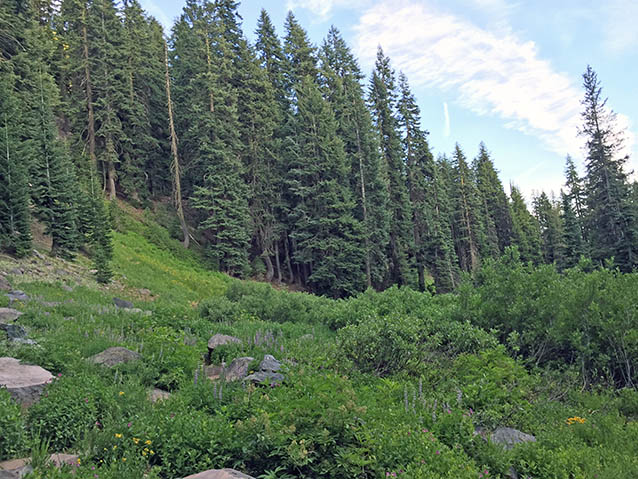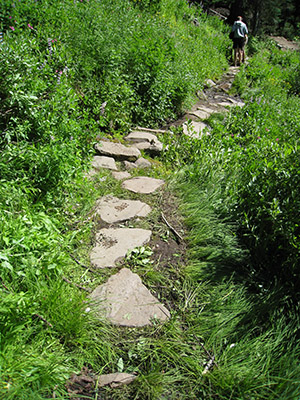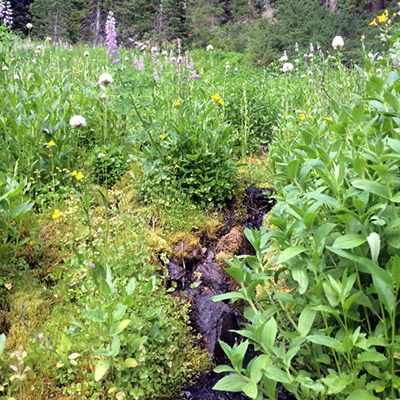Castle Crest Wildflower Trail is a 0.40-mile interpretive trail that loops around a meadow below Castle Crest Ridge. Originally built in 1929, the trail was created to provide visitor access to and interpretation of one of the most abundant wildflower displays in the park. In addition to its connection to the early development of Crater Lake’s education program, the Castle Crest Wildflower Trail was a local manifestation of a the wider NPS educational movement.
Nature is the supreme school-teacher as well as the master textbook. USDOI Report of the Director of the National Park Service to the Secretary of the Interior, June 30, 1926 page 6.

NPS

NPS
Castle Crest Wildflower Trail was constructed in 1929, and it remains an important example of early National Park Service educational program development of the 1920s and 1930s. It demonstrates several of the techniques used to interpret a park’s natural resources during this period, incorporating both a self-guided nature trail and a wildflower garden.
The Castle Crest Wildflower Trail is significant as the first trail and wildflower garden planned, constructed, and used specifically for interpretational purposes as part of Crater Lake National Park’s educational program. The early development of this program was highly influenced by Dr. John C. Merriam, who was appointed in 1928 by the Secretary of the Interior to a committee to study educational possibilities of the national parks.
From 1928 to 1945, Merriam developed the educational program at Crater Lake, using the park as experimental grounds. Merriam intended for Crater Lake’s educational program to become an example for all parks to follow. Merriam established the interpretational foundations of the education program by determining the park’s interpretive theme: the processes of volcanism and its influence in the creation of the Crater Lake landscape. During this time, eleven nature trails were built specifically for interpretation purposes. These trails were differentiated from bridle trails and fire access trails in the park master plans. The Castle Crest Wildflower Trail was the first of these interpretative trails.

NPS Photo, June 2015
Castle Crest Wildflower Trail, originally called the “Castle Crest Garden,” is also one example of the wild flower displays that were created in several national parks in the 1920s and 1930s. Wildflowers were typically displayed at the parks using two main techniques: 1) a cut flower display, labeled and maintained at the park’s museum, naturalist’s office, or lodge, or 2) a labeled wildflower garden.
These wildflower gardens were usually created by either transplanting native flowers to a designed garden site or into an existing meadow to increase the density and variety of blooming plants. Alternatively, some wildflower gardens made use of existing meadows by simply adding paths. In all cases, the flora was labeled to facilitate plant identification by visitors. Crater Lake’s Castle Crest Wildflower Trail was one of the first wildflower gardens created in the national park service.
The wildflower meadow or “garden," is bowl shaped – enclosed on the north and east by Castle Crest Ridge towering 2,000’ above, and on the south and west by low moraines. Five springs create moist conditions within the meadow that support a prolific wildflower community. The trail continues to follow its historic alignment and provide visitors an interpretive opportunity of the wildflower displays.
Quick Facts
- Cultural Landscape Type: Historic Site
- National Register Significance Level: State
- National Register Significance Criteria: A
- Period of Significance: 1929-1938
Landscape Links
- Cultural Landscape Inventory Park Report
- Library of Congress: American Memory Collection
- Landscape Flickr Album
- NPGallery Photos
- More about NPS Cultural Landscapes
Last updated: November 19, 2020
